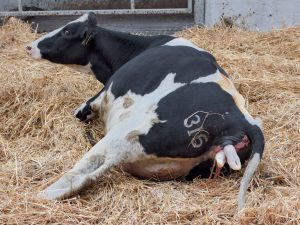Preparation for Autumn Calving
September 14, 2020
On many dairy farms autumn cows will be starting to calve and emphasis switches from grazing and silage making to planning for the winter housing and feeding period, management of the transition cow, care of the new-born calf and housing requirements.

CAFRE Dairy Development Adviser Gavin Duffy says “It has been well documented the importance of management of the dry cow with particular emphasis on the period 3 to 4 weeks pre-calving. A high incidence of production diseases such as milk fever, retained cleanings and stomach problems in fresh calved cows can very often be traced back to management of the dry cow. The higher the milk yield potential of the cow, the greater the challenge and as many diseases are interlinked some cows can often suffer multiple problems.”
Gavin recommends “cows should be dried off at the same body condition score that they calve down at, normally around 2.75- 3.0. As condition score may vary within the herd it is recommended to score the herd 8 to10 weeks before the target dry off date so corrective action can be taken. Provided condition score is close to target, cows in the early dry period may be kept outdoors in late summer/autumn on low grass covers, supplemented if necessary with an additional forage such as silage or straw. It is recommended that cows in the close up dry period should be housed so that their specific nutritional needs can be more closely met.”
Whatever the system, Gavin Duffy outlines a number of factors that should form the basic rules for practical management of the close up dry cow group
- Allow plenty of feed space for pre-calvers, at least 75 cm per cow (Holsteins) and 24 hours/day stress-free access to fresh, palatable feed;
- Constant availability of fresh, clean water, with adequate water trough space per cow or one fast drinker per 10 cows;
- Avoid overcrowding of the pre-calving group.
- Avoid moving cows close to calving wherever possible. Moving causes stress, delays calving and reduces feed intakes even further. If cows are moved between groups, move in at least pairs;
- Cows housed in cubicles need extra large and comfortable beds with similar attention to detail such as hygiene as that for the milking herd.
A well thought out management protocol for the care of the cow at calving and the newborn calf is an essential requirement on the modern dairy farm especially where there may be a number of different personnel involved. Provision of an adequate number of clean, disinfected and well bedded calving pens is recommended with good health and safety management a key consideration. Individual pens should be suitably equipped to allow animals at calving to be easily restrained, should be draught free and have good lighting. It is important calving pens are cleaned out regularly, are well washed, disinfected and rested before reuse.
“Whilst careful management around calving will minimise potential problems, it is good practice to be well prepared for every eventuality” states Gavin Duffy. He continued “check the calving store to ensure there is a calving aid and clean ropes, essential medical supplies including calcium /magnesium bottles in case of suspected milk fever cases, a supply of iodine to treat the calf’s naval and a back-up of good quality colostrum plus a hygienic means of administering this important first feed. In addition it is a legal requirement that newborn dairy calves are identified with an all numeric approved plastic tag in each ear within 36 hours of birth. This task is most accurately carried out when the cow and her calf are still together in the calving pen. Preparations should be in place to have suitable clean, dry, well bedded and hygienic rearing facilities available for these calves.”
The feeding of the fresh calved cow can often be very specific to individual farms depending on for example the lactation number and milk yield potential of the herd, the feeding system on the farm and the quantity and quality of feed available. However there are a few basic principles that are common across all farms to help ensure the feed is delivered as planned. Gavin recommends that farmers:-
- Analyse the available forages to determine how much milk can be produced from these alone, where possible feeding the best quality material to the highest yielding cows.
- Calibrate parlour feeders –Significant improvements can be made in production, health and cost savings where cows are accurately fed according to their nutritional plan. In too many cases farmers spend a lot of money on nutrition advice, ration formulation and specific concentrates to suit their needs but when parlour feeders are inaccurate, potential benefits are being lost.
Gavin Duffy concluded that attention to detail during the latter part of the dry period and around calving will help prepare the autumn calving cow for her subsequent lactation and minimise potential production and health problems. Planning should include a review, not only of nutrition but also accommodation, health, cow welfare with a particular emphasis on health and safety. Time spent servicing equipment, acquiring essential supplies and developing critical management protocols will pay dividends.
A range of advisory notes on dry cow management are available on the CAFRE website, including feeding, forage mineral analysis, transition cow management and the layout of the CAFRE Dry Cow House.
